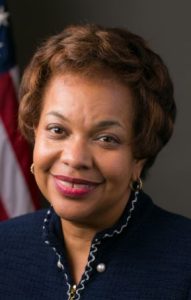 (Editor's note: This select print feature originally appeared in the December 2016 issue of MReport magazine.)
(Editor's note: This select print feature originally appeared in the December 2016 issue of MReport magazine.)
Sandra Thompson took time to speak with MReport about her work at the Federal Housing Finance Agency—where she serves as Deputy Director of the Division of Housing Mission and Goals—and about how the diversity landscape has changed in the housing and financial industry over the course of her 30-year career. Prior to joining FHFA she held senior leadership positions with the FDIC and Goldman Sachs. She values the opportunity to be a public servant, having said, “You can’t overstate the rewards that come from knowing that the work that you’re doing impacts millions of people and their finances every single day, whether it’s housing or banking.”
M // What will be the focus of your work for policy development for the GSEs in 2017?
THOMPSON // We’ve spent the past several years focused on Fannie’s and Freddie’s response to the housing crisis. These efforts included initiatives that supported home retention, availability of mortgage credit, and also strengthening some of their risk management practices. Next year, you’ll start to see our work pivot toward post-crisis opportunities, especially after offerings like HAMP and HARP come to an end. We’ll likely announce more details on a high LTV refinance option as a kind of a quasireplacement for HARP and a post-crisis modification to address life after HAMP. We’re going to probably complete some of the work that’s been on the scorecard for Fannie and Freddie for the past few years around alternate credit scores. We know that many institutions are starting to use or leverage technology in the mortgage process, and, as a byproduct, the enterprises can continue to think about how to best leverage technology in their business practices. We’re going to continue to work on the affordable housing needs of borrowers like millennials, seniors, retirees, workforce, and multigenerational households. We’re going to continue to promote liquidity in the housing market, as that is one of our statutory responsibilities. Along those lines, our primary focus is making sure that we have responsible access to credit by borrowers from all segments of the market.
M // What steps are involved in the process of changing existing policy or adopting new ones?
THOMPSON // Our first step when someone proposes to change a policy or procedure or adopt a new one is figuring out what the problem we are trying to solve is. Once we have adequately defined the problem, we establish a project plan. A project plan includes a charter, a scope, and timetables.
Then we start collecting evidence, including any data that is available. We conduct stakeholder outreach, which I can’t emphasize enough—is crucial to solving any issue. We want to make sure we get ample feedback so that we understand the impact that this proposed policy change would have on all the stakeholders. The last thing we want to do is create a policy that has unintended consequences. Once we get all that input, we analyze the evidence and figure out some policy options. Often, there is just not a single solution to a particular issue. We weigh the pros and cons of different options and their impact on a range of stakeholders. Then we propose options and a recommendation that we socialize. I think we really go out of our way to develop a deep understanding of an issue in order to provide the agency’s director with a thoughtful analysis that will help him make the final policy choice. The mortgage and housing markets touch borrowers, investors, lenders, sellers, and servicers. There are so many participants in the process that you have to do thorough research and analysis on any issue to really understand the impact of any proposed solution on all of the stakeholders. In some cases, after policies are put in place, we conduct afteraction reviews to see if those policies have been applied in the way that we thought that they should.

Sandra Thompson
M // What challenges have you faced as a minority woman in the housing and financial industry over the course of your career?
THOMPSON // I was the first woman and first African American to be head of the risk management division at the FDIC, and when I joined Goldman Sachs in 1986, there weren’t very many women and there certainly weren’t very many minorities. At the management level in the private sector or in the federal government, you walk into a room and sometimes you’re the only female or you are the only minority. You have to get over that fairly quickly. It does register, or it did when I first dealt with it. Sometimes I would walk into a meeting and I would be the senior official there and most people did not expect that.
M // How can women and minorities work to overcome similar challenges?
THOMPSON // We need to take more risks, and we need to get out of our comfort zone. At times, women and minorities don’t speak up in meetings, perhaps because we feel like we have to have all of the answers. That is just not the case with non-minority men. I read an article where it said that women apply for promotions and opportunities only if they thought they met 100 percent of the qualifications for that particular job, and men applied when they met less than 100 percent of the qualifications. This isn’t my quote, but I find it to be my truth: Under-qualified and under-prepared men don’t think twice about leaning in, and over-qualified and over-prepared women will hold back. I think that minorities and women really only feel confident when they’re perfect or practically perfect. For example, we don’t usually answer questions unless we’re completely sure of our answers. Sometimes we let our non-minority or non-women colleagues take risks and we don’t. We take the safe route. I’ve been in meetings where one of two things has happened: An issue came up and I was thinking something and I didn’t say it, and the next thing you know somebody else says what I was thinking. Or the other thing that happens is I said what I was thinking and people acted like they didn’t hear it. Then another colleague, a non-minority, nonwoman, said exactly what I said, and it’s like a new revelation and the greatest idea ever. And I always end up thinking, “Why didn’t I say what I had to say?”
M // Where do you think this need among women and minorities to be ‘perfect’ originates?
THOMPSON // I don’t know if it goes to a fear of many nonminorities thinking you’re underqualified or you got the job not because of your qualifications but because of some sort of, I hate to use the term, “affirmative action,” but there’s some notion in there that really goes to the heart of our confidence that we need to get over. The competence is there, but I think the confidence is an area that we really need to focus on. My mentors at Goldman Sachs, Neil Levin and Howard Altarescu, and also John Bovenzi at the FDIC, really helped change my thinking. They taught me how to dismiss the mental noise and key in on the issues at hand. I learned to highlight the facts, understand and communicate the evidence so I could stay focused and deliver a databased presentation. They said that the rest would fall into place, and people would learn to rely on me and seek me out to work on projects. They said, “It’s important to remember that the worst thing that could happen is you’re wrong.” You don’t want to be wrong too many times, but you need to start somewhere and take some gradual steps.
M // What advice do you have for women who are just starting in the industry who are trying to break in?
THOMPSON // Take chances and be open. If you’re in an organization, I always recommend that people go on detailed assignments. You can get locked into a particular office or a particular division’s way of thinking. Broaden your perspective and understand the entire organization to the best of your ability. Understand where you fit in with your organization, and try to make yourself invaluable. Do something new; do something different. You might not like it, but at least you’ve tried it. and you can make an informed decision when you’re making your career choices. These are the types of things that build confidence and credibility. I say, just go for it.

 theMReport.com Your trusted source for mortgage banking news
theMReport.com Your trusted source for mortgage banking news









